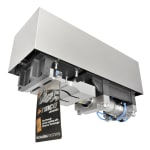
Rinco Ultrasonics plans to showcase new ultrasonic film sealing equipment at Pack Expo International 2025, booth SU-30019, from September 29 to October 1 in Las Vegas. The exhibit will feature the FPA4500EM system, described by the company as the industry's first fully servo-driven ultrasonic pouch sealer, and the Micro-35 packaging actuator designed for continuous fin sealing and zipper crushing. According to sales manager Bill Aurand, the latest designs focus on higher productivity and reduced energy consumption. The servo architecture in the pouch sealer enables dynamic manipulation of vibratory amplitude, weld force and stroke velocity during the cycle to support weld strength at the shortest possible cycle time, while eliminating compressed air for seal force to lower energy use. Integrated force and position monitoring can detect folded or missing pouches, which may reduce reliance on upstream presence sensors and simplify integration on pouch filling machines. The Micro-35 targets compact installations and continuous movement applications where the actuator travels with the film, combining a small form factor with energy efficiency for modern packaging lines.
FPA4500EM servo-driven pouch sealer
The FPA4500EM is a fully servo-driven ultrasonic pouch sealing system. By replacing pneumatic force generation with servo control, the unit reduces energy consumption and provides precise control over key parameters throughout the weld cycle. The system dynamically adjusts vibratory amplitude, weld force and stroke velocity to reconcile seal integrity with cycle time requirements. Force and position feedback also underpin error detection, including folded or missing pouches. Historically, filling machines have used sensors to confirm pouch presence before welding to protect ultrasonic tools; Rinco indicates that integrated monitoring in the FPA4500EM can help streamline such interfaces.

Micro-35 packaging actuator
The Micro-35 actuator is designed for continuous fin sealing and zipper crushing in flexible packaging. The compact and lightweight form factor supports installation in tight spaces and use in continuous movement zipper crushing where the actuator moves with the film. Operating at 35 kHz, the design uses standard components to deliver high power for continuous seals and is described as reliable and nearly silent. A robust integrated positive stop protects tooling if film is absent, and integrated air-cooling ports help stabilize the ultrasonic sealing process. Aurand noted, "We've developed a highly adaptable ultrasonic system that is repeatable, user friendly, and safe."

Process considerations and sustainability
Ultrasonic fin sealing creates continuous, hermetic longitudinal seals by passing film between ultrasonic tools rather than heated jaws. Ultrasonic zipper crushing facilitates hermetic side seals on stand-up pouches with zippers. Because sealing energy is delivered ultrasonically and localized, films can be melted almost instantaneously. Energy demand is lower than with thermal sealing; Rinco indicates that thermal fin seal jaws can draw up to ten times the wattage of a typical ultrasonic unit. In addition, conventional heat-seal jaws often require 10 to 15 minutes of warm-up at shift start or after service, while ultrasonic systems do not, which can improve machine availability.
Ultrasonic sealing is also presented as a more sustainable approach with the ability to seal recycled and bio-based films as well as many paper-based materials. Some of these substrates are sensitive to thermal processes, which can yield leaky or wrinkled bonds. Ultrasonic systems offer process control and data capture for insight into the sealing operation, whereas thermal processes are often affected by ambient conditions and provide limited in-process confirmation of seal quality. From an operational standpoint, ultrasonic sealing is maintenance-friendly and typically requires minimal operator adjustment.



